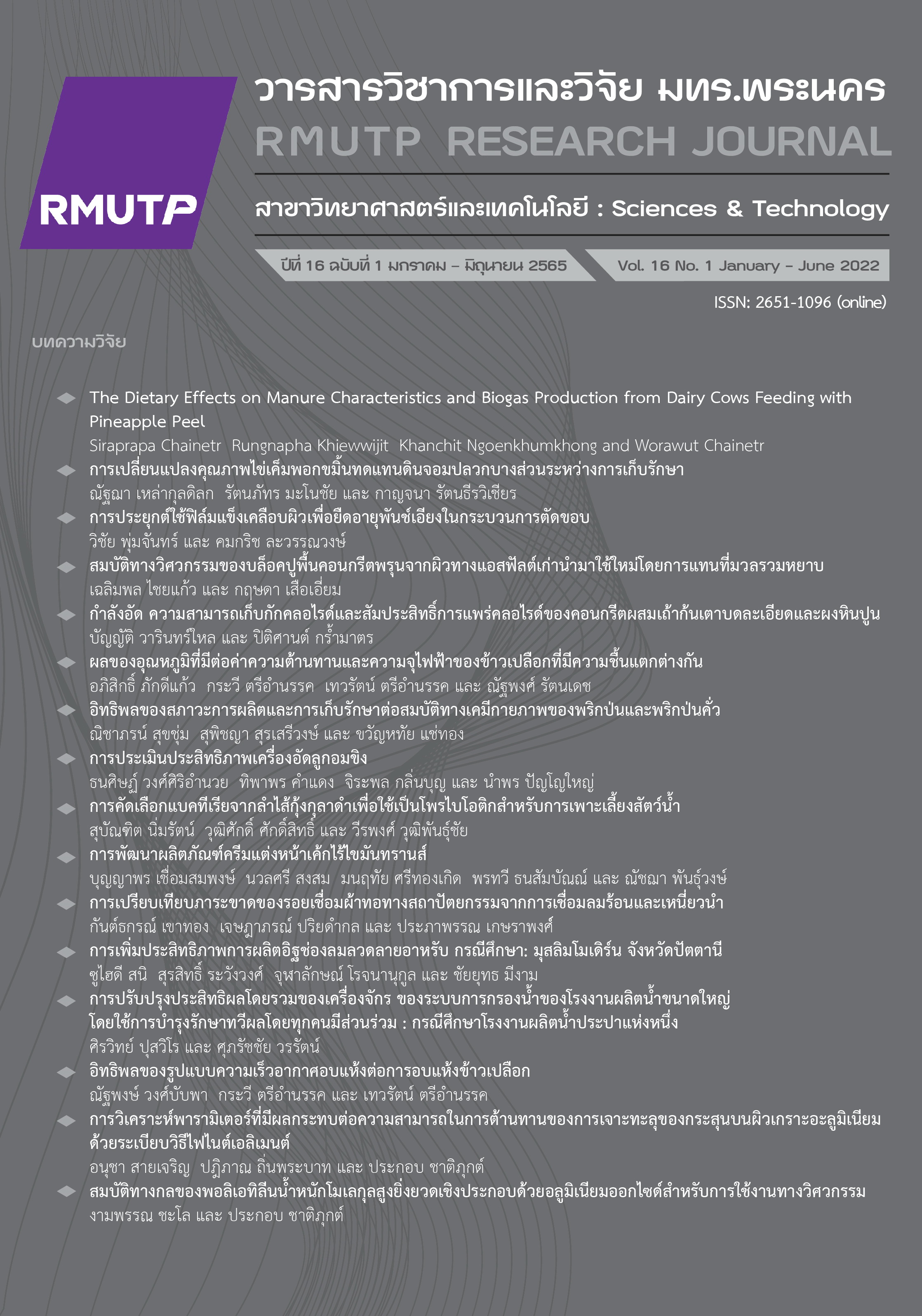อิทธิพลของสภาวะการผลิตและการเก็บรักษาต่อสมบัติทางเคมีกายภาพของพริกป่นและพริกป่นคั่ว
Main Article Content
บทคัดย่อ
การพัฒนาผลิตภัณฑ์พริกป่นโดยการสำรวจทัศนคติ และความต้องการของผู้บริโภคเพื่อนำมาใช้เป็นข้อมูลในการพัฒนาพริกป่นคุณภาพสูง ศึกษาการเปลี่ยนแปลงคุณภาพ และสมบัติทางเคมีกายภาพระหว่างเก็บ เริ่มจากนำพริกสดเฉพาะที่มีผลดี สีแดง ล้างและลวกในน้ำที่อุณหภูมิ 100 องศาเซลเซียส เป็นเวลา 3 นาที จากนั้นแช่พริกลวกในสารละลายโซเดียมเมตาไบซัลไฟต์ ร้อยละ 0.25 ร่วมกับ กรดซิตริก ร้อยละ 1.0 เป็นเวลา 30 นาที อบแห้งด้วยตู้อบลมร้อน ที่อุณหภูมิ 65 องศาเซลเซียส เป็นเวลา 14 ชั่วโมง จนได้พริกแห้งความชื้นประมาณร้อยละ 8 นำพริกแห้งที่ได้เด็ดก้านแล้วมาบดเป็นพริกป่น การคั่วพริกแห้งก่อนนำไปบดเป็นพริกป่นส่งผลต่อการลดลงของค่าความชื้น ค่าวอเตอร์
แอคติวิตี้ ค่าสี และค่าอะฟลาทอกซิน ผลการศึกษาการเปลี่ยนแปลงคุณภาพของพริกป่นระหว่างเก็บพบว่าอุณหภูมิเป็นปัจจัยหลักที่ส่งผลต่อการเปลี่ยนแปลงสมบัติทางเคมีกายภาพและร้อยละการยอมรับของผู้บริโภค ขณะที่บรรจุภัณฑ์ชนิดอลูมิเนียมฟอยล์ช่วยชะลอการเพิ่มขึ้นของปริมาณอะฟลาทอกซินในพริกป่นได้ดีกว่าบรรจุภัณฑ์ชนิดโพลิโพรพิลีน อย่างไรก็ตามผลิตภัณฑ์พริกป่นที่พัฒนาได้มีจำนวนเชื้อแบคทีเรียกลุ่มแอโรบิกในปริมาณต่ำมากเมื่อเปรียบเทียบกับมาตรฐาน ไม่พบยีสต์และรา และมีปริมาณสารพิษอะฟลาทอกซินอยู่ในเกณฑ์มาตรฐานภายหลังการเก็บนาน 12 สัปดาห์ ในทุกสภาวะ ซึ่งสอดคล้องกับความต้องการของผู้บริโภคที่ตระหนักถึงคุณภาพ ความสะอาด และความปลอดภัยเป็นปัจจัยสำคัญในการตัดสินใจเลือกซื้อผลิตภัณฑ์จากพริก
Article Details

This work is licensed under a Creative Commons Attribution-NonCommercial-NoDerivatives 4.0 International License.
ลิขสิทธ์ ของมหาวิทยาลัยเทคโนโลยีราชมงคลพระนครReferences
P. Wiriya, T. Paiboon and S. Somchat, “Effect of drying air temperature and chemical pretreatments on quality of dried chill,” International Food Research Journal, vol. 16, pp. 441-454, 2009.
U. Mustafa, M. Ali, T. Satapornvorasak and O. Dissataporn, “Food Chain Analysis: Setting Research Priorities,” in Proceeding of Asia – Thailand, Taiwan, 2006, pp. 197-24.
Ministry of Commerce. (2020, December 2). Import-Export Structure of Menucom [Online]. Available: http://www2.ops3.moc.go.th/
R. I. Nogueira, F. E. P. Cornejo, W. A. L. Junior, H. R. Bizzo, R. Antoniassi and S. P. Freitas, “Effects of drying parameters on pepper (Capsicum spp.),” in Proceeding of 2nd Mercosur Congress on Chemical Engineering and 4th Mercosur Congress on Process Systems Engineering, Brasil, 2005, pp. 154-159.
Office of Agricultural Economics. (2021, June 29). Dried chili import statistics in 2020 [Online]. Available: http://impexp.oae.go.th/service/import.php?S_YEAR=2563&E_YEAR=2563&PRODUCT_GROUP=5251&PRODUCT_ID=3827&wf_search=&WF_SEARCH=Y
C. Chuaysrinule, T. Maneeboon, C. Roopkham and W. Mahakarnchanakul, “Occurrence of aflatoxin- and ochratoxin A-producing Aspergillus species in Thai dried chilli,” Journal of Agriculture and Food Research, vol. 2, Dec. 2020.
P. Rungnaphar. (2018, December 4). The Development of Quality for safety chili [Online]. Available: https://www3.rdi.ku.ac.
th/?p=41431
L. B. Bullerman and A. Bianchini, “Stability of mycotoxin during food processing,” International Journal of Food Microbiology, vol. 119, pp. 140-146, 2007.
P. Suchart, Social science research methodology, 1st ed. Bangkok: Lieng Chiang Printing House, 1997.
P. Kotler, Marketing Management: Analysis, Planning, Implementation, and Control, 9th ed. New Jersey: Prentice-Hall Inc, 1997.
K. Chaethong and R. Pongsawatmanit, “Influence of sodium metabisulfite and citric acid in soaking process after blanching on quality and storage stability of dried chili,” Journal of Food Processing and Preservation, vol. 39, no. 6, pp. 2161–2170, 2015.
Official methods of analysis of AOAC International. 17th ed. Maryland: Gaithersburg Md., 2000.
M. Contreras-Padilla and E. M. Yahia, “Changes in capsaicinoids during development, maturation, and senescence of chili peppers and relation with peroxidase activity,” Journal of Agricultural and Food Chemistry, vol. 46, no. 6, pp. 2075–2079. 1998.
BAM. (2001a). (2017, October 17). Bacteriological Analytical Manual Chapter 3: Aerobic Plate Count. In FDA Bacteriological Analytical Manual [Online]. Available:http://www.cfsan.fda.Gov/~ebam/bam-3.html
BAM. (2001b). (2017, October 17). Bacteriological Analytical Manual Chapter 18: Yeasts Molds and Microtoxins. In FDA Bacteriological Analytical Manual [Online]. Available:http://www.cfsan.fda.gov/ebam/bam-18.html
C. Bonazzi and E. Dumoulin, “Quality changes in food materials as influenced by drying processes,” in Modern Drying Technology, vol. 1, E. Tsotsas and A. S. Mujumdar, 1st ed. Weinheim, Germany: Wiley-VCH GmbH, 2011, pp. 1–20.
Thai Agricultural Standard, Pub. L. No. TAS 3004-2017, 2017.
J. E. Hodge, “Dehydrated Foods, Chemistry of Browning Reactions in Model Systems,” Journal of Agricultural and Food Chemistry, vol. 1, no. 15, pp. 928-943, 1953.
D. D. Kitts, C. H. Wu, A. Kopec and T. Nagasawa, “Chemistry and genotoxicity of caramelized sucrose,” Molecular Nutrition Food Research, vol. 50, no. 12, pp.1180-1190, Dec. 2006.
S. Kim, K. W. Lee, J. Park, H. J. Lee and I. K. Hwang, “Effect of drying in antioxidant activity and changes of ascorbic acid and colour by different drying and storage in Korean red pepper (Capsicum annuum L.),” International Journal of Food Science & Technology, vol. 41, pp. 90-95, 2006.
Thai Agricultural Standard, Pub. L. No. TAS 3001-2010, 2010.
R. Farahmandfar and B. Tirgarian, “Degradation of aflatoxins and tocopherols in peanut (Arachis hypogaea): Effect of aflatoxin type, time and temperature of roasting,” Drying Technology, vol. 38, no. 16, pp. 2182-2189, 2020.
M. J. Jay, Modern food microbiology, 1st ed. Gaithersburg: Aspen Publishers, 1998.
R. L. Coleman, C. J. Wagner, W. L. Bryan and R. E. Berry, “Preliminary evaluations of sulfite pretreatments for sun-dried and hot air-dried green peppers,” Proceedings of the Florida State Horticultural Society, Florida, vol. 91, pp. 146-148, 2012.
D. S. Lee, S. K. Chung, H. K. Kim and K. L. Yam, “Nonenzymatic browning in dried red pepper products,” Journal of Food Quality, vol. 14, pp. 153-163, 1991.
R. Addala, M. Vasavada, J. Dong and S. Subramanian, “Effect of storage conditions on rate of color degradation of paprika based products,” Journal of Fixed Point Theory and Applications, vol. 6, pp. 423, 2015.
M. Rattanaporn, “Quality and Process Improvement of Chilli Powder,” M.S. thesis, Kasetsart Univ., Bangkok, Thailand, 2003.
S. Ruangchai and S. Tantakasem "Storage Quality of Tamarind Chili Paste mixed Roselle,” University of the Thai Chamber of Commerce Journal, vol. 31, no. 2, pp. 89-98, 2011.
P. Thippaya, E. Siriporn, S. Warunee and R. Songpon, Contamination of aflatoxins in legume-base processed food, 1st ed. Bangkok: Technical and Planning Division, Food and Drug Administration. Ministry of Public Health, 1987.
B. Kabak, “The fate of mycotoxins during thermal food processing,” Journal of the Science of Food and Agriculture, vol. 89, pp. 549-554, 2009.

